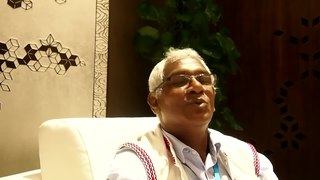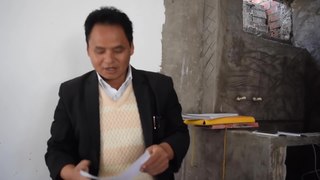Related Research Articles

Modern Standard Hindi, commonly referred to as Hindi, is an Indo-Aryan language spoken chiefly in Northern India, and serves as the lingua franca of the Hindi Belt region encompassing parts of northern, central, eastern, and western India. Hindi has been described as a standardised and Sanskritised register of the Hindustani language, which itself is based primarily on the Khariboli dialect of Delhi and neighbouring areas of North India. Hindi, written in the Devanagari script, is one of the two official languages of the Government of India, along with English. It is an official language in nine states and three union territories and an additional official language in three other states. Hindi is also one of the 22 scheduled languages of the Republic of India.

India is the most populous country in the world with one-sixth of the world's population. According to official estimates in 2022, India's population stood at over 1.42 billion.

Languages spoken in the Republic of India belong to several language families, the major ones being the Indo-Aryan languages spoken by 78.05% of Indians and the Dravidian languages spoken by 19.64% of Indians, both families together are sometimes known as Indic languages. Languages spoken by the remaining 2.31% of the population belong to the Austroasiatic, Sino–Tibetan, Tai–Kadai, and a few other minor language families and isolates. As per the People's Linguistic Survey of India, India has the second highest number of languages (780), after Papua New Guinea (840). Ethnologue lists a lower number of 456.

Sindhi is an Indo-Aryan language spoken by about 30 million people in the Pakistani province of Sindh, where it has official status. It is also spoken by a further 1.7 million people in India, where it is a scheduled language, without any state-level official status. The main writing system is the Perso-Arabic script, which accounts for the majority of the Sindhi literature and is the only one currently used in Pakistan. In India, both the Perso-Arabic script and Devanagari are used.

India is a federal union comprising 28 states and 8 union territories, with a total of 36 entities. The states and union territories are further subdivided into districts and smaller administrative divisions.

Kurukh, also Kurux, Oraon or Uranw, is a Dravidian language spoken by the Kurukh (Oraon) and Kisan people of East India. It is spoken by about two million people in the Indian states of Jharkhand, Chhattisgarh, Odisha, West Bengal, Assam, Bihar and Tripura, as well as by 65,000 in northern Bangladesh, 28,600 of a dialect called Uranw in Nepal and about 5,000 in Bhutan. Some Kurukh speakers are in Andaman and Nicobar Islands. It is most closely related to the Malto language. It is marked as being in a "vulnerable" state in UNESCO's list of endangered languages. The Kisan dialect has 206,100 speakers as of 2011.

The Kharia language is a Munda language of the Austroasiatic language family, that is primarily spoken by the Kharia people of eastern India.
Battle of Yunnan-Burma Road was the name of the Chinese intervention to aid their British allies in the 1942 Burma Campaign. Its forces were composed of the Fifth, Sixth and Sixty-sixth Army under the command of the Chinese Expeditionary Force in Burma, commanded by Lt. General Joseph Stilwell, Lt. General Luo Zhuoying was his executive officer.

The Karenni, also known as the Kayah or Kayah Li, are a Karen people native to the Kayah State of Myanmar (Burma).
War, also known as War-Jaintia, is an Austroasiatic language spoken by about 16,000 people in Bangladesh and 51,000 people in India. The language is spoken by the War Khasi tribe, i.e. War sub-tribe of Khasi people.

Halbi is an Eastern Indo-Aryan language, transitional between Odia and Marathi. It is spoken by at least 766,297 people across the central part of India.
Mawachi a region in the Bawlake district of the Kayah State of Myanmar.

S’gaw, S'gaw Karen, or S’gaw K’Nyaw, commonly known as Karen, is a Sino-Tibetan language spoken by the S'gaw Karen people of Myanmar and Thailand. A Karenic branch of the Sino-Tibetan language family, S'gaw Karen is spoken by over 2 million people in Tanintharyi Region, Ayeyarwady Region, Yangon Region, and Bago Region in Myanmar, and about 1 million in northern and western Thailand along the border near Kayin State. It is written using the S'gaw Karen alphabet, derived from the Burmese script, although a Latin-based script is also in use among the S'gaw Karen in northwestern Thailand.

Maring and Uipo (Khoibu) are closely related Sino-Tibetan languages spoken by the Maring Naga and Khoibu (Uipo) Naga of India. Linguistically, they are closest to the Tangkhulic languages.
Lyngngam is an Austroasiatic language of Northeast India closely related to Khasi language. Once listed as a dialect of Khasi, Lyngngam has in recent literature been classified as a distinct language. Lyngngam speakers have food and dress similar to the neighboring Garo people.

Bhatri is an Eastern Indo-Aryan language spoken by the Bhottada tribe in Chhattisgarh and Odisha, India. The language is spoken predominantly in eastern Bastar district and in Koraput and Nabarangpur districts of Odisha.

Surjapuri is an Eastern Indo-Aryan language is an eastern Indo-Aryan language of the Bengali-Assamese branch, spoken in Eastern India including North Bengal, West Bengal, and Banganchal of Eastern Bihar, as well as Jhapa District in Nepal, Goalpara Division of Assam in India and Rangpur Division in Bangladesh. Among speakers in some regions, it is known as 'Deshi Bhasa'. It possesses similarities with Kamatapuri, Assamese, Bengali, and Maithili.

Sirmauri is a Western Pahari language spoken in the Sirmaur district in the northern Indian state of Himachal Pradesh. Its two main varieties are Dharthi and Giripari.

Jaunsari is a Western Pahari language of northern India spoken by the Jaunsari people in the Chakrata and Kalsi blocks of Dehradun district in the Garhwal region of Uttarakhand state.

Tomio Mizokami is a professor Emeritus of Osaka University, Japan. In 2018, he was conferred the Padma Sri by the President of India, at the Civil Investiture Ceremony on 2 April 2018, for his contribution to the fields of literature and education.
References
- ↑ "Statement 1: Abstract of speakers' strength of languages and mother tongues - 2011". www.censusindia.gov.in. Office of the Registrar General & Census Commissioner, India. Retrieved 2018-07-07.
- ↑ Mawchi language at Ethnologue (19th ed., 2016)
